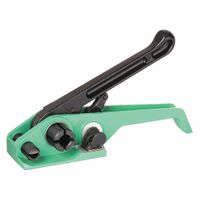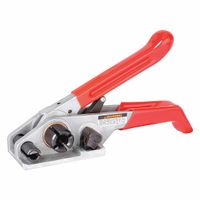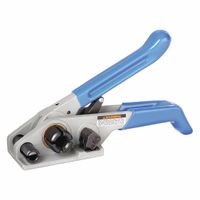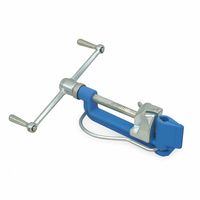Call +(254) 703 030 000 / 751 483 999 / 721 704 777
- Home
- Packaging Shipping
- Strapping
- Strapping Tools
.....Read More
Frequently Asked Questions
What are the different types of strapping tools and their uses?
Strapping tools are essential for securing and bundling items with strapping materials like steel, polyester, or polypropylene. The main types of strapping tools include:
1. **Manual Strapping Tools**:
- **Tensioners**: Used to tighten the strap around the package. Suitable for low-volume applications.
- **Sealers**: Crimp seals onto the strap to secure it. Used in conjunction with tensioners.
- **Combination Tools**: Combine tensioning, sealing, and cutting in one tool. Ideal for small to medium operations.
2. **Pneumatic Strapping Tools**:
- Use compressed air to tension, seal, and cut the strap. Suitable for medium to high-volume applications. They reduce operator fatigue and increase efficiency.
3. **Battery-Powered Strapping Tools**:
- Portable and use rechargeable batteries. They offer mobility and are suitable for various volumes. They provide consistent tension and sealing.
4. **Automatic Strapping Machines**:
- Fully automate the strapping process. Ideal for high-volume operations. They can be integrated into production lines for efficiency.
5. **Semi-Automatic Strapping Machines**:
- Require manual placement of the strap but automate tensioning and sealing. Suitable for medium-volume operations.
6. **Steel Strapping Tools**:
- Specifically designed for steel straps, including manual and pneumatic options. Used for heavy-duty applications.
7. **Plastic Strapping Tools**:
- Designed for polyester or polypropylene straps. Available in manual, pneumatic, and battery-powered versions.
Each type of tool is chosen based on the volume of strapping, the material of the strap, and the specific application requirements.
How do you choose the right strapping tool for your material?
To choose the right strapping tool for your material, consider the following factors:
1. **Material Type**: Determine whether you are strapping plastic (polypropylene or polyester) or metal (steel) materials. Each material requires specific tools designed to handle its properties.
2. **Strap Size**: Identify the width and thickness of the strap you will be using. Strapping tools are designed to accommodate specific strap sizes, so ensure compatibility.
3. **Tension Requirements**: Assess the tension needed to secure your load. Different tools offer varying tension levels, and the choice depends on the load's weight and stability requirements.
4. **Volume and Frequency**: Consider the volume and frequency of your strapping operations. For high-volume applications, automated or pneumatic tools may be more efficient, while manual tools might suffice for low-volume needs.
5. **Portability**: Evaluate the need for portability. If strapping is required in multiple locations, lightweight and battery-operated tools offer greater mobility.
6. **Budget**: Determine your budget constraints. Manual tools are generally more cost-effective, while automated tools, though more expensive, offer increased efficiency and reduced labor costs.
7. **Operator Skill Level**: Consider the skill level of the operators. Some tools require more training and expertise, while others are user-friendly and suitable for beginners.
8. **Environment**: Take into account the working environment. For outdoor or harsh conditions, choose tools that are durable and resistant to environmental factors.
9. **Safety Features**: Look for tools with safety features to protect operators from potential injuries during use.
10. **Brand and Support**: Choose reputable brands that offer reliable customer support and service options.
By evaluating these factors, you can select a strapping tool that meets your specific material and operational needs effectively.
What is the difference between manual, pneumatic, and battery-powered strapping tools?
Manual strapping tools require human effort to tension, seal, and cut the strapping material. They are cost-effective and suitable for low-volume applications. These tools are lightweight and portable, making them ideal for small businesses or operations with limited strapping needs. However, they can be labor-intensive and time-consuming, leading to operator fatigue.
Pneumatic strapping tools use compressed air to automate the tensioning and sealing process. They are faster and more efficient than manual tools, reducing operator fatigue and increasing productivity. Pneumatic tools are suitable for medium to high-volume applications and provide consistent tension and seal quality. However, they require an air compressor, which can limit mobility and increase setup costs.
Battery-powered strapping tools are cordless and use rechargeable batteries to automate the strapping process. They offer the convenience of mobility and are easy to use, making them suitable for various applications. These tools provide consistent tension and sealing, improving efficiency and reducing operator fatigue. Battery-powered tools are ideal for medium to high-volume operations but can be more expensive than manual tools. They require regular battery charging and maintenance.
How do you properly tension, seal, and cut strapping?
To properly tension, seal, and cut strapping, follow these steps:
1. **Preparation**: Choose the appropriate strapping material (steel, polyester, or polypropylene) based on the load's weight and stability requirements. Ensure you have the necessary tools: a tensioner, a sealer, and a cutter.
2. **Positioning**: Wrap the strapping around the package or pallet. Ensure it is positioned correctly, typically horizontally or vertically, depending on the load's shape and stability needs.
3. **Tensioning**:
- Insert the strapping into the tensioner tool. For manual tensioners, thread the strapping through the tool's slots.
- Crank the tensioner handle to tighten the strapping around the load. Ensure the strapping is snug but not overly tight to avoid damaging the load or the strapping itself.
4. **Sealing**:
- Place a seal over the overlapping ends of the strapping. The type of seal (open, closed, or snap-on) depends on the strapping material and tool compatibility.
- Use a sealer tool to crimp the seal onto the strapping. Position the sealer over the seal and squeeze the handles firmly to secure the seal, ensuring the strapping ends are locked in place.
5. **Cutting**:
- Use a cutter to trim the excess strapping. Position the cutter close to the seal to minimize waste and ensure a neat finish.
- Ensure the cut is clean to prevent sharp edges that could pose safety hazards.
6. **Final Check**: Inspect the strapping to ensure it is secure and properly tensioned. Adjust if necessary to maintain load stability during transport or storage.
What are the common problems and solutions when using strapping tools?
Common problems when using strapping tools include:
1. **Improper Tensioning**: Over-tensioning can damage the product, while under-tensioning can lead to loose straps.
- *Solution*: Use a tensioner with adjustable settings and ensure operators are trained to apply the correct tension for different materials.
2. **Tool Malfunction**: Mechanical or battery-operated tools may jam or fail.
- *Solution*: Regular maintenance and cleaning of tools, along with timely replacement of worn parts, can prevent malfunctions.
3. **Incorrect Strap Alignment**: Misalignment can cause ineffective sealing or strap breakage.
- *Solution*: Ensure the strap is properly aligned in the tool and use guides or alignment aids if necessary.
4. **Seal Failure**: Poor sealing can result from incorrect tool settings or worn seals.
- *Solution*: Regularly check and adjust the sealing mechanism and replace worn seals promptly.
5. **Operator Fatigue**: Manual tools can cause fatigue, leading to errors.
- *Solution*: Use ergonomic tools or automated systems to reduce physical strain on operators.
6. **Incompatible Strap and Tool**: Using the wrong type or size of strap for a tool can cause inefficiency.
- *Solution*: Match the strap type and size with the tool specifications and ensure compatibility.
7. **Battery Issues**: For battery-operated tools, battery failure can halt operations.
- *Solution*: Keep spare batteries charged and follow proper charging protocols to extend battery life.
8. **Safety Hazards**: Improper use can lead to injuries.
- *Solution*: Provide comprehensive training on tool use and safety protocols, and ensure the use of personal protective equipment.
By addressing these issues with proper training, maintenance, and tool selection, the efficiency and safety of strapping operations can be significantly improved.
How do you maintain and care for strapping tools?
To maintain and care for strapping tools, follow these steps:
1. **Regular Cleaning**: After each use, clean the tools to remove dust, dirt, and debris. Use a soft cloth or brush to wipe down surfaces, ensuring that no residue is left that could affect performance.
2. **Lubrication**: Apply appropriate lubricants to moving parts to ensure smooth operation. Focus on joints, gears, and any other components that experience friction. Use manufacturer-recommended lubricants to avoid damage.
3. **Inspection**: Regularly inspect the tools for signs of wear and tear. Check for loose screws, worn-out parts, or any damage that could compromise functionality. Pay special attention to the tensioning mechanism and cutting blades.
4. **Blade Maintenance**: For tools with cutting blades, ensure they are sharp and free from nicks. Dull blades should be sharpened or replaced to maintain clean cuts and prevent strain on the tool.
5. **Calibration**: Periodically check the tension settings to ensure they are accurate. Miscalibration can lead to improper strapping, which can affect the security of the packaged goods.
6. **Storage**: Store tools in a dry, clean environment to prevent rust and corrosion. Use protective cases or covers to shield them from dust and moisture.
7. **Training**: Ensure that all users are properly trained in the operation and maintenance of the tools. Misuse can lead to damage and reduce the lifespan of the equipment.
8. **Manufacturer Guidelines**: Follow the manufacturer’s maintenance schedule and guidelines. This includes any specific instructions for cleaning, lubrication, and part replacement.
9. **Professional Servicing**: For complex issues or regular servicing, consult a professional or the manufacturer’s service center to ensure the tools are maintained to the highest standard.
By adhering to these practices, you can extend the life of your strapping tools and ensure they function efficiently.
What safety precautions should be taken when using strapping tools?
When using strapping tools, several safety precautions should be observed to ensure the safety of the operator and those nearby:
1. **Personal Protective Equipment (PPE):** Always wear appropriate PPE, including safety glasses, gloves, and steel-toed boots, to protect against potential injuries from sharp edges or heavy materials.
2. **Training:** Ensure that all operators are adequately trained in the use of strapping tools and understand the specific instructions and safety guidelines provided by the manufacturer.
3. **Inspection:** Regularly inspect strapping tools for any signs of wear, damage, or malfunction. Do not use tools that are damaged or defective.
4. **Work Area:** Keep the work area clean and free of obstructions. Ensure there is adequate lighting and space to operate the tools safely.
5. **Proper Use:** Use the strapping tools only for their intended purpose. Follow the manufacturer's instructions for operation, including tensioning and sealing procedures.
6. **Body Positioning:** Maintain a safe body position to avoid strain or injury. Keep hands and other body parts away from the strapping path and tool mechanisms during operation.
7. **Strap Handling:** Handle strapping materials carefully to avoid cuts or injuries. Use appropriate dispensers to manage strap unwinding and prevent tangling.
8. **Tensioning:** Do not over-tension the strap, as this can cause it to snap and potentially cause injury. Use the correct tension settings for the material being strapped.
9. **Cutting:** Use appropriate cutting tools to cut strapping materials. Ensure that the cutting area is clear of other materials and body parts.
10. **Storage:** Store strapping tools and materials in a safe, dry place when not in use to prevent damage and ensure they are ready for safe operation.
By adhering to these precautions, the risk of accidents and injuries can be significantly reduced.




